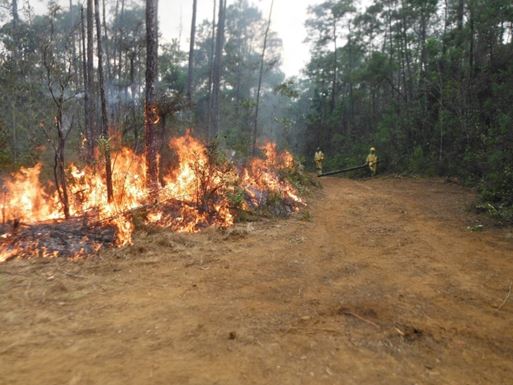Provincial system of protected areas in Guantanamo, fire´s destructive role vs. benefits
Main Article Content
Abstract
The work was carried out in the Provincial System of Protected Areas (SPAP) of Guantánamo, in a period of eight years, from 2014 to 2022. The objectives were focused on evaluating the destructive role of fire in protected areas and reinforcing protection active and passive to neutralize the damage of this phenomenon in their biophysical integrity. The methodology used focused on the compilation of statistical information, descriptive statistical analysis and history of the fires that occurred, identification of sites and ecosystems prone to fire. The results showed that 29.1% of the protected areas of Guantánamo were affected by these phenomena. In the evaluated period, the highest frequency of occurrences was in the year 2021 with 9. According to the threshold established by the Cuban Ranger Corps (5-50ha), 93.6% of the fires turned out to be of low proportions.
Article Details

This work is licensed under a Creative Commons Attribution-NonCommercial 4.0 International License.
References
Begué-Quiala, G., Rivera, D.G, García de la Cruz, A., Imbert Planas, J. R., Romero Romero, R., Laurencio Matos et al. (2021). Informe final de la evaluación de los impactos provocados por el incendio forestal en área del Parque Nacional Alejandro de Humboldt, provincia de Guantánamo y Holguín, Cuba. Inédito. Unidad Presupuestada de Servicios Ambientales Alejandro de Humboldt. Delegación Territorial del CITMA Guantánamo, pp. 1-34.
Begué-Quiala, G., Pérez Trejo, H. M., Russo, O. M. & Martínez, J. (2018). Aspectos de la ecología del querequeté (Chordeiles gundlachii) en Guantánamo, Cuba. Revista. Hombre, Ciencia y Tecnología Vol. 22 No.2., pp. 54-64
Cardil, A., y Molina, D. (2013). Largue wildland fires in tree diverse regiogs in Spain from 1978 to 2010. En: Forest Systems, Vol. 22. No. 13.
Castellnou, M., & Miralles, M. (2009). The changing face of wildfires. Crisis Response, 5(4), 56-57.
Castellnou, M., Nebot, E., & Miralles, M. (2007, May). El papel del fuego en la gestión del paisaje. In 4th International Wildland Fire Conference, Seville, Spain (pp. 13-17).
Halvorson, W. L. y G. E. Davis, comps. (1996). Science and Ecosystem Management in the National Parks, University of Arizona Press, Tueson, Estados Unidos.
Forestal, C. N. (2010). Incendios forestales, Guía práctica para comunicadores. CN FORESTAL, Incendios forestales, Guía práctica para comunicadores. México. p. 56
IUCN (2000). Unión International para la Conservación de la Naturaleza. Co-management of Natural Recursos.
Primack, R., Rozzi, R. C., & Feinsinger, P. (2001). Establecimiento de áreas protegidas. En: Fundamentos de conservación biológica. Perspectivas latinoamericanas. Fondo de Cultura Económica, México.
Primack, R., Rozzi, R. C., Massardo, F. & Feinsinger, P. (2001). Destrucción y degradación del hábitat. En: Fundamentos de conservación biológica. Perspectivas latinoamericanas. Fondo de Cultura Económica, México
Plan SNAP 2023-2030. Centro Nacional de Áreas Protegidas de, Agencia de Medio Ambiente, Ministerio de Ciencia, Tecnología y Medio Ambiente. p.55
Plan SNAP 2014-2020. Centro Nacional de áreas Protegidas de, Agencia de Medio Ambiente, Ministerio de Ciencia, Tecnología y Medio Ambiente. p.337
Marone, L., Milesi, F., González del Solar, R., Mezquida, E. T., Lopez de Casenave, J., & Cueto, V. (2002). La teoría de evolución por selección natural como premisa de la investigación ecológica. Interciencia, 27(3), 137-142. pp. 137-142.
Nota de Prensa (2023). Cuerpo de Guardabosques de Cuba. Ministerio del Interior.Periódico Granma. Enero 19.
ONEI (2020). Oficina Nacional de Estadística e Información. República de Cuba. Panorama Ambiental.
SEMARNAT (2018). Secretaría de Medio Ambiente y Recursos Naturales Incendios forestales, 99% provocados por el hombre. México.
Padrón Castañeda, N., & Barranco Reyes, J. (2014). Cambio climático e incendios de 5a generación. Riesgos naturales y cambio climático. Colegio de Ingenieros de Montes, 81-90. pp. 1-8.
The Nature Conservancy (2004). El Fuego, los Ecosistemas y la Gente. Iniciativa Mundial sobre el Fuego. http://nature.org/fire

